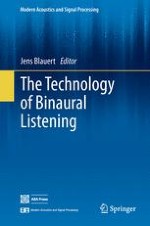2013 | OriginalPaper | Buchkapitel
Modeling Horizontal Localization of Complex Sounds in the Impaired and Aided Impaired Auditory System
verfasst von : N. Le Goff, J. M. Buchholz, T. Dau
Erschienen in: The Technology of Binaural Listening
Verlag: Springer Berlin Heidelberg
Aktivieren Sie unsere intelligente Suche, um passende Fachinhalte oder Patente zu finden.
Wählen Sie Textabschnitte aus um mit Künstlicher Intelligenz passenden Patente zu finden. powered by
Markieren Sie Textabschnitte, um KI-gestützt weitere passende Inhalte zu finden. powered by
